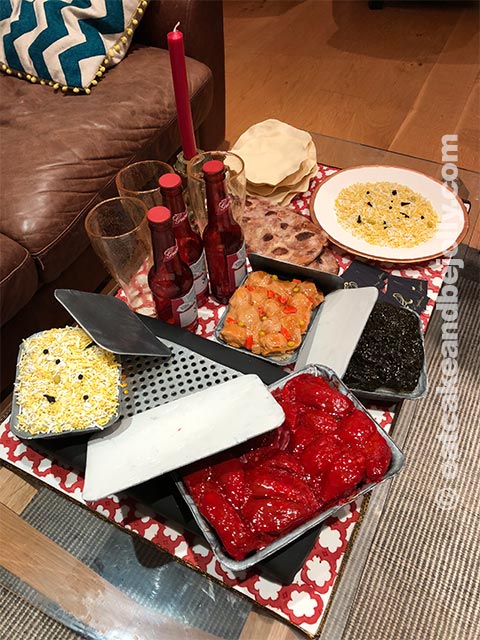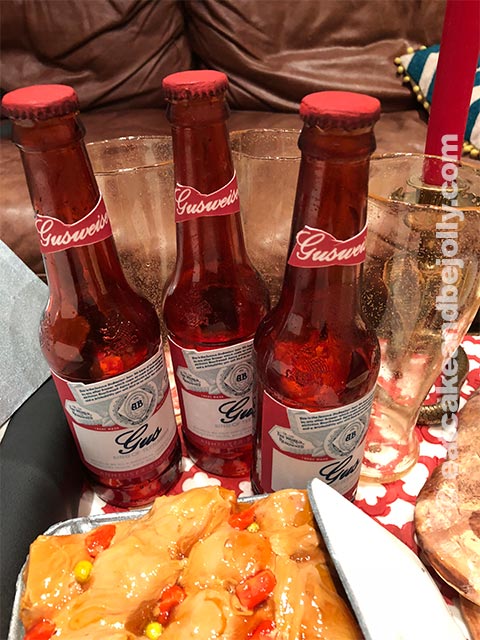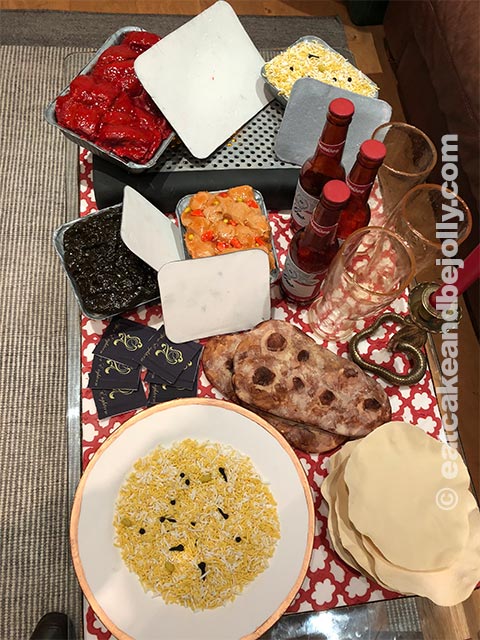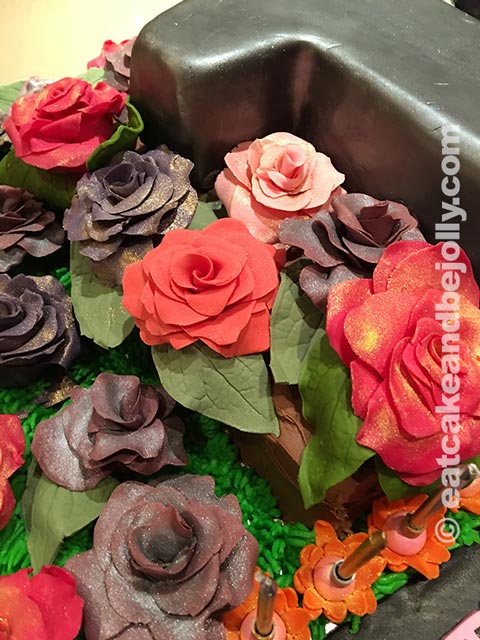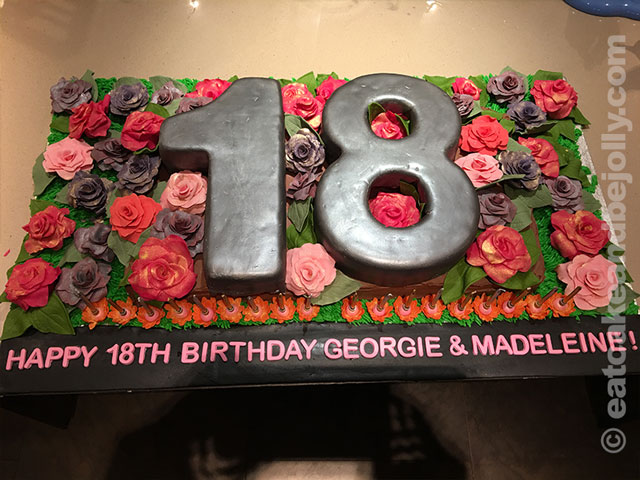Gus’ 18th Birthday Curry Cake (2018)
When I asked my Nephew, Gus, what theme he wanted for his cake, his answer was ‘Well, my favourite thing is curry’! So a curry cake it was. This project grew and grew. I started off making take-away aluminium food containers and lids out of pastillage and spraying them silver. I made curry ‘toppers’ to fit on top of these containers – chicken tikka masala; saag (spinach); and a chicken curry with carrots and peas. These I filled with either millionaire’s salted caramel shortbread or marzipan cake with a marzipan buttercream, as Gus and his father are very keen on marzipan.
I also made naan breads and poppadums out of pastillage, as well as a dinner plate. The naan bread I coloured using edible paints. On the plate I added a gold rim using edible gold paint. I dried the poppadums on crinkled foil to give them some texture and shape. Pilau rice, in two colours – white and yellow, was easy to make from sugarpaste with a potato ricer, cutting the extruded ‘rice’ when it was the right length, but I also added in a few sugarpaste peppercorns, cloves and cardamom pods to make it look authentic.
But then I wondered about the possibility of making an edible bottle of beer. MYOM makes a great kit and set of videos for producing a beer bottle silicone mould. I also printed out edible beer bottle labels with Gus’s name on them (Gusweiser). Once the mould was produced, it was relatively quick to make a dozen bottles, as they only needed to cool for around fifteen minutes before they could be de-moulded. I used clear Isomalt coloured with edible brown airbrush paint. Once I had got it to the right temperature, crucially I left it in a hot oven for fifteen minutes to help remove the bubbles. This made the final bottles much less flawed.
The labels didn’t need any glue, as the sugar was slightly sticky and the labels attached easily. I also then bought their beer glass mould kit, which contained the glass itself and again worked really well. These are what they use as props in the movies for smashing bottles/glasses over people’s heads, and Gus’s sister enjoyed smashing one of the beer bottles over his head at his birthday party!
I also thought about the ‘after-curry mint’. After Eight mints are the classic choice here in the UK, so I mocked up a version of the individual pouch design, using the clock logo, and called them ‘After Eighteen’, as this is his eighteenth birthday. I then got around twenty of these printed on edible sugar sheets which I cut out and then folded over, inserting an actual mint in each, to create pouches that are completely edible. The edible sugar sheets stuck well when pressed together without needing any glue.
Whilst these were all great components, there were around thirty people at the birthday party and there wasn’t enough cake for everyone. So I used my favourite chocolate Oreo cake recipe, with Oreo buttercream, to make a tea light food warmer, which is a common feature in Indian restaurants in the UK. I covered the cake in black sugarpaste, with three holes for (electric) tea lights to simulate the real thing. I got an impression mat with a grid pattern and rolled out a thin layer of sugarpaste with lots of CMC glue in it. I let this harden, then sprayed it silver and varnished it with edible paint, to create the effect of a metal grille to go on top of the tea lights. The effect was great and this allowed me to put some of the take-away containers on top and create enough space for the other items on the cake board.
For the candles, I thought about buying beer bottle candles, but decided to go for a real candlestick with an Indian cobra design and a large candle, to make it feel more like an Indian restaurant.
The cake board had a covering of white sugarpaste, but rippled to make it look like a tablecloth. I then used a stencil and red sugarpaste to make a pattern that I, and my girls, replicated across the tablecloth. The girls are now old enough to be genuinely helpful with the cakes. The cake board was finished with a colourful Indian ribbon.
The party was a family affair with his god-parents and just a few friends, but I made extra sugar bottles, glasses, mints and cake for Gus to take back to school to share with his friends.
Georgie and her friend Madeleine’s 18th Birthday Cake (2016)
My niece, Georgie was having an 18th birthday party and requested a cake from her uncle. She didn’t give any specific brief, but asked, simply, that it be sophisticated. Exactly what an 18-year old considers sophisticated is something that I could easily get wrong, so I went for something that I though was not going to be controversial and used sparkly roses as the theme, with cake letters for 18 made from vanilla madeira cake with a chocolate ganache filling and crumb coat, finished with white sugarpaste covered in edible silver powder. This was all set on top of a chocolate Oreo cake with an Oreo buttercream filling and frosting.
I found some flower candle holders that I put along the front of the cake, together with pink lettering. I used a rose maker stencil for the roses, which I had never really made before, and was very happy with how it worked: https://www.youtube.com/watch?v=lQESOumomkM. I used pre-coloured sugar florist pastes, which is great for rolling very thin. When they had hardened, I dusted them with edible metallic lustre dusts.
I also used a silicone leaf veiner for the leaves, which also worked really well.
Having an uncle at your 18th birthday party was clearly not something that was going to work, so I wasn’t able to see how they reacted. However, apparently they were bowled over and ate every single piece of the cake apart from the candles, including all the roses!
Fat Duck – Botrytis Cinerea (2016)
Probably my favourite restaurant in the world, the Fat Duck and its head chef, Heston Blumenthal have been at the forefront of molecular cuisine for decades now. The best dessert I have ever eaten is their deconstruction of Chateau d’Yquem, the finest dessert wine in the world. I was completely blown away by the combination of flavours, textures and temperatures that astonishingly recreate this great ‘noble rot’ wine.
Having tasted it numerous times at the restaurant, I was keen to attempt to recreate it at home. But the recipe was not seemingly available. Until it was used as a competition dish by Heston Blumenthal in the final of Australian MasterChef. All dishes from the show are posted online, so I finally had the recipe!
The bad news is that the dish required 23 separate components, some of them requiring me to learn completely new techniques (one of which, I have to admit, eluded me) and a stack of technical ingredients that I have never used before.
I made this for a Valentine’s night dinner for my wife, Dara and our ‘foodie’ friends, Todd and Kacie. An absurd amount of work for one dish for four people for one evening, but one of the most fun things I have ever done in my life! Not quite as delicately presented as the Fat Duck version (by this stage of the evening, a few bottles of wine had been consumed, so the plating was rather clumsy), but all the elements tasted as they should have.


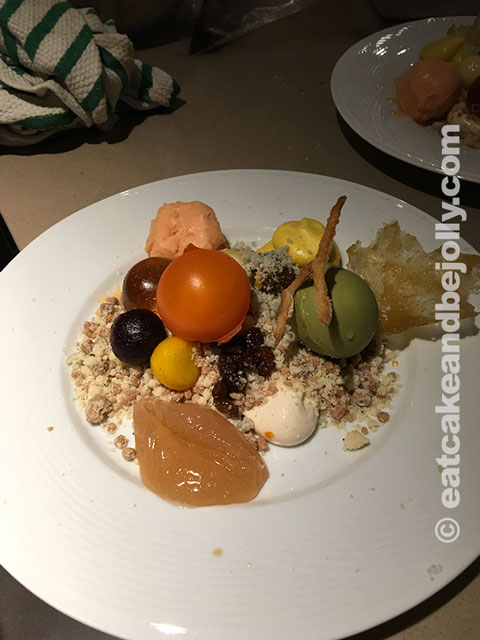
Looking back on it all now, I can’t quite believe how much work this was! I have listed the recipe below. Here are a few points that I found:
- I just did one colour of grape leaf (green) to make it a bit more simple
- The quantities for each component vary considerably in how many they will serve – many of these components will create enough for 20 people
- I enjoyed using the dehydrator. It was relatively cheap to buy and the aerated saffron ‘meringues’ worked very well (they do expand a bit whilst drying, so don’t make them too big). The grapes took longer than anticipated to dry out, but you could easily just buy large Muscat raisins. The grape leaves also took a bit longer than expected to dry out.
- The method calls for a Thermomix. I don’t have one and whilst I borrowed one from a neighbour, her clear instructions still proved beyond me! So, I just used a blender where I needed to blend stuff and a saucepan on the stove when I needed to heat stuff. I really didn’t miss it at all.
- Many of the components, such as all the frozen ones, the peach jellies, the saffron aerated ‘meringues’ and the melon balls, can be made a few weeks in advance. There is actually very little that needs doing just before serving.

A dehydrator similar to the one I bought
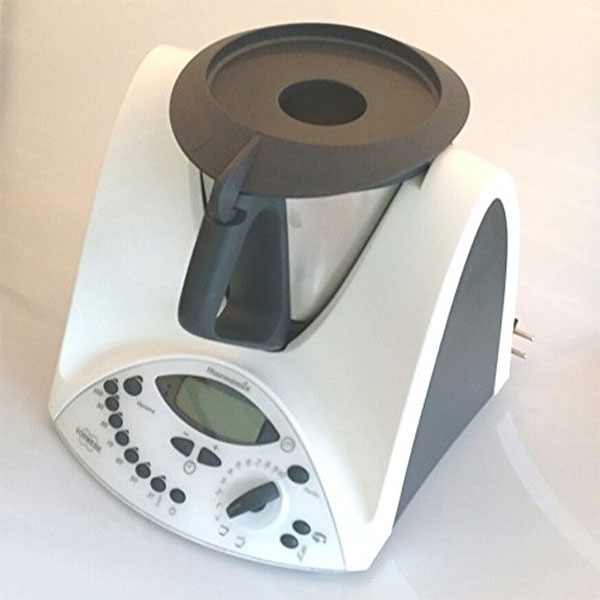
The ever-confounding Thermomix
INGREDIENTS BY COMPONENT
| For the Grape Leaves |
| Green Paste |
| 1000g Green grape, puree |
| 500g Refined Isomalt |
| 35g Glucose Syrup |
| 20g Gellan F |
| 2.5g Malic Acid |
| 1g Salt |
| Purple Paste |
| 1000g Black Muscat grape, puree |
| 500g Refined Isomalt |
| 35g Glucose Syrup |
| 20g Gellan F |
| 2.5g Malic Acid |
| 1g Salt |
| For the Cinnamon Sugar (to coat the Churros Stems) |
| 55g Ground Fenugreek |
| 1000g unrefined golden caster sugar |
| 30g Ground cinnamon |
| For the Churros Stems |
| 1000g Water |
| 130g Grape seed oil |
| 185g White caster sugar |
| 12.5g Salt |
| 500g Flour, sifted |
| For the Grape Vinegar Fluid Gel |
| 1800g White grape juice |
| 18g Gellan F |
| 300g Minus 8 ice wine vinegar (this is very expensive, so I just used white wine vinegar) |
| 120g Muscat wine |
| For the Fenugreek Syrup (for one of pear balls) |
| 300g Fructose |
| 400g Water |
| 35g Fenugreek |
| 2g Tartaric Acid |
| Saffron Vanilla Syrup (for the other pear ball) |
| French Commis Pear |
| 10 Vanilla Pods |
| 600g Fructose |
| 900g Water |
| 0.5g Saffron |
| 7.5g Malic Acid |
| For the Citrus Sorbet |
| 100g Pink grapefruit segments, strained |
| 700g Orange segments, strained |
| 60g Lemon segments, strained |
| 50g Lime segments, strained |
| For the Citrus Jelly |
| 25g Powder gelatine |
| 1000g Reserved citrus juice from segmenting for the sorbet |
| 200g Fructose |
| 10g Minus 8 Ice wine vinegar (this is very expensive, so I just used white wine vinegar) |
| For the Frozen Grapes |
| 500g Black Muscat grapes, seeds removed |
| 4g Powder gelatine |
| 1000g Citrus jelly (see recipe above) |
| For the Grape Colouring Base |
| 20g Kirsch |
| 20g Strawberry red colouring powder |
| 40g Yellow colouring powder |
| 10g Pistachio green colouring powder |
| For the Grape Sugar Bubble To be honest, I ran out of time to practice blowing sugar, so I just melted everything and then used a spherical mould to create half-spheres, which I then stuck together by gently melting the edges. These were thicker than if they had been blown, but by this stage of the process I was tired, running out of time and had had a few drinks! |
| 540g Water |
| 200g Isomalt |
| 700g Glucose syrup |
| 10g Citric acid |
| 50g Grape colouring base (see recipe above) |
| For the Fromage Blanc cream |
| 800g Fromage blanc, hanged for 48 hours (hanging the soft cheese a cheese cloth or tea towel helps drain excess liquid) |
| 200 Citrus puree reduction (see recipe above) |
| 80g Icing sugar |
| 4ml Orange blossom water |
| For the Citrus Puree Reduction |
| 1000g Blood orange puree |
| 1000g Mandarin puree |
| 1000g Pink grapefruit puree |
| 500g Lemon puree |
| For the Aerated Saffron Grape juice |
| 1000g Fresh green grape puree |
| 1g Saffron |
| 200g Fresh green grape puree saffron infusion |
| 100g Trehalose sugar |
| 1.4g Whey protein (this is such a tiny amount if you are just buying it for this recipe…) |
| 6g Egg white powder |
| For the Pear Caramel Filling |
| 1800g Fresh pears, well ripen |
| 50g Malic acid |
| 1080g Glucose syrup |
| 1440g Caster sugar |
| 360g Unsalted butter |
| 1200g Whipping cream, warm |
| For the Coloured cocoa butter |
| 2000g Cocoa butter |
| 30g Green chocolate colouring powder |
| 20g Yellow chocolate colouring powder |
| 6g Red chocolate colouring powder |
| For the Pear Caramel Chocolate Balls |
| 1000g Valrhona Ivoire, white chocolate |
| 100g Coloured cocoa powder |
| 100g Pailleté Feuilletine (very fine crispy, lacey biscuits – I just used bought Crêpes Dentelles) |
| 100g Popping Candy |
| For the Purple Peach Wine Gum |
| 240g Glucose syrup |
| 15g Unrefined caster sugar |
| 930g Peche de Vigne (peach liqueur – I used the one from Edmond Briottet. Useful to have in the cupboard for mixing with Champagne…) |
| 4.5 Tartaric Acid |
| 48g Powder Gelatine |
| For the Soaked Grapes |
| 1500g White dried sultanas |
| 750g Sauternes |
| For the Grape seed oil crumble |
| 1800g Flour |
| 1800g Corn starch |
| 900g Icing sugar |
| 1200g Grape seed oil |
| 600g Unsalted butter, melted |
| For the Crystallised Chocolate |
| 1200g Valrhona Ivoire, white chocolate |
| 75g Valrhona Guanaja, Dark chocolate |
| 1500g Water |
| 150g White caster sugar |
| For the Vanilla Salt |
| 5g Vanilla Powder |
| 60g Welsh salt (or just any salt!) |
| For the Soil OK, so this sounds crazy, but this combination of components works remarkably well. So much going on, just in the base of the dish… |
| 400g Grape seed oil crumble |
| 400g Crystallised chocolate |
| 30g Vanilla Salt |
| 40g Roquefort powder |
| For the Roquefort Powder |
| 200g Roquefort cheese |
| 120g Valrhona Ivoire, white chocolate |
| 240g Tapioca maltodextrin |
METHOD
For the Grape Leaves
Using a high-speed blender, place the rinsed and dried grapes in the jug. Blitz at maximum speed for 5 minutes or until smooth. Pour the mixture into a Thermomix jug and add the rest of the ingredients.
Put all the ingredients together in Thermomix and blitz, setting the temperature to 90˚C, speed 5. It will take approximately for 3 minutes. Turn the Thermomix of and allow to cool until the temperature reaches below 30˚C.
Place the jug back on the Thermomix and blitz at speed 6 until smooth, scraping occasionally.
Using leaf stencil spread the green leaf paste onto a baking sheet. And dry at 70˚C in a dehydrator for 2 hours.
In the meantime, repeat the process above for the “red paste”. After the 2 hours, brush purple leaf paste on the semi dried green leaf surface to make botrytis diseased effect. Place back in the dehydrator at 70˚C for 48 hours. (It should be crispy and clear colour).
Place the leaf stamp and the tray in a 100˚C preheated oven to warm up for 2 minutes. Place a piece of leaf on a leaf stamp and warm up the leaf using a heat gun. Press with the other side of the leaf mould in order to make a leaf shape. Store in an air tight container with food grade silica gel.
For the Grape Leaves
Using a high-speed blender, place the rinsed and dried grapes in the jug. Blitz at maximum speed for 5 minutes or until smooth. Pour the mixture into a Thermomix jug and add the rest of the ingredients.
Put all the ingredients together in Thermomix and blitz, setting the temperature to 90˚C, speed 5. It will take approximately for 3 minutes. Turn the Thermomix of and allow to cool until the temperature reaches below 30˚C.
Place the jug back on the Thermomix and blitz at speed 6 until smooth, scraping occasionally.
Using leaf stencil spread the green leaf paste onto a baking sheet. And dry at 70˚C in a dehydrator for 2 hours.
In the meantime, repeat the process above for the “red paste”. After the 2 hours, brush purple leaf paste on the semi dried green leaf surface to make botrytis diseased effect. Place back in the dehydrator at 70˚C for 48 hours. (It should be crispy and clear colour).
Place the leaf stamp and the tray in a 100˚C preheated oven to warm up for 2 minutes. Place a piece of leaf on a leaf stamp and warm up the leaf using a heat gun. Press with the other side of the leaf mould in order to make a leaf shape. Store in an air tight container with food grade silica gel.
For the Cinnamon Sugar
Place the fenugreek in the jug of a Thermomix. Blitz for a few minutes to a fine powder. Add the sugar and ground cinnamon and blitz for 1 minute at speed 5. Reserve in an air tight container.
For the Churros Stems
Place the water, oil, sugar and salt in a pan over medium high heat. Bring to a boil and take off from the heat and gradually whisk in the sifted our avoiding any lumps. Place the dough into a disposal piping bag fitted with a 2mm nozzle, pipe the dough on a parchment sheet following a stem patterned previously outlined.
Place the tray in a 200˚C preheated oven for 2 minutes at 0% humidity, fan off. Brush the stems with grape seed oil, making sure to cover the entire surface of the dough.
Place the tray back in the oven and cook for further 15 minutes, turn the tray around and cook until golden in colour.
Remove any excess oil on paper and dust the entire stem with the cinnamon fenugreek sugar.
For the Grape Vinegar Fluid Gel
Place grape juice in the jug of a Thermomix, set the machine to 100˚C at speed 2. Add the Gellan F, increase the speed to 4 and continue blitzing for a further 4 minutes. Allow the mixture to cool completely, until set.
Place the set jelly in the jug of a high-speed blender; add the vinegar and the Muscat wine. Blitz until smooth.
For the Fenugreek Syrup
Place all the ingredients in a pan over medium high heat and bring to a boil. Pour the ingredients into a container, allow over an iced water bath, allow to cool completely, place a lid on top and place in the fridge, allow to infuse for 24 hours. Strain through a Chinois (otherwise called a conical sieve) and reserve. Using Parisian scoop, #15 and #18, shape pear into round spheres. Place 60 pear spheres in a sous vide bag with 80g syrup and just seal (Depends on the ripeness need to repeat). Store in a fridge for 12 hours.
Saffron Vanilla Syrup
Place scraped vanilla seeds, pods, saffron, malic acid, sugar and water in a pan and bring to a boil. Pour the ingredients into a container, allow over an iced water bath, allow to cool completely, place a lid on top and place in the fridge, allow to infuse for 24 hours. Strain through a Chinois and reserve. Using Parisian scoop, #15 and #18, shape pear into round spheres. Place 60 pear spheres in a sous vide bag with 80g syrup and just seal (Depends on the ripeness need to repeat). Store in a fridge for 12 hours.
For the Citrus Sorbet
Cut all the citrus into segment and strain any excess juice by placing them on a Chinois over a container. Do not disregard the juices. Using a high seed blender, blitz all the citrus segment at maximum speed for 3 minutes.
For every 900g of juice base, add 100g fructose, 80g trimoline and 20g vodka, if necessary, add juice and cool it down in an ice bath. Before churning, add 300g of sour cream for every 1000g of base.
Churn for 7 minutes and dispense into a container, making sure to press down so that they are no air pockets. Form the mixture into spheres in a lightly greased sphere silicon mould.
For the Citrus Jelly
Sprinkle powder gelatine over 100 g of citrus juice and allow to stand for 20 minutes. Pour the mixture into a pan over low medium heat stir until dissolve. Add the fructose and stir until fully dissolved. Remove from the heat, allow to cool slightly and add the rest of the juice. Reserve.
For the Frozen Grapes
Place the seedless grapes is the jug of a high-speed blender and blitz at maximum speed for 5 minutes. In the meantime, soak the gelatine powder in 20g of the grape puree for 20 minutes. Pour the mixture into a pan over low medium heat and stir until the gelatine has dissolved. Add the rest of the grape juice. Pipe the grape jelly mixture in a mould and freeze in the blast chillers. Stick toothpicks into the frozen grapes and place back to the blast chillers. De-mould the sphere s and place on a piece of Styrofoam by sticking the toothpick into the foam, making sure they are standing up straight. Place back in the freezer.
To form the grapes, allow the citrus jelly to cool down to 24˚C. Take each frozen sphere and deep into the
liquid nitrogen and then dip into the citrus jelly. Place back on the Styrofoam and back in the freezer, before serving; pour liquid nitrogen on top to get the frost effect.
For the Grape Colouring Base
Mix all the ingredients together in a bowl until fully combined. Reserve.
For the Grape Sugar Bubble
Place water, glucose and Isomalt in a pan over medium high heat and cook to a temperature of 140oC. Add citric acid and colouring. Continue heating up the mixture to 165˚C. Pour the sugar syrup onto a silicon mat and allow to cool slightly. Once the sugar has begun to set, begin pulling the sides in. Continue to stretch, pull and turn the sugar. Once ready, cut a small portion of the sugar out and roll it into a small bowl. Insert the metal tube of a sugar pump into one of the sides of the sugar bowl and begin pumping gently to make the bubbles.
To make sugar spiral vine, pull a small portion of the sugar to a thin strand and wrap it around a thin cylindrical object. Allow to set for a few minutes. Reserve all sugar work in air tight container.
For the Fromage Blanc cream
Place of all the ingredients together in a bowl and mix until well combined. Put the mixture in a piping bag and reserve in the fridge
For the Citrus Puree Reduction
Place all the ingredients in a pan over medium heat and cook until the liquid has reduced to 1000g. Reserve in the fridge
For the Aerated Saffron Grape juice
Place 200g of the green grape puree in a pan over medium heat; allow to come to a boil. Remove from the heat, add the saffron and allow to stand for 1 hour. Add 800g of the remaining puree to the infusion.
Place the 200g of infused grape puree in a mixing bowl and add the Trehalose sugar, whey protein and egg white powder. Combine well using a whisk. Pour the mixture into the bowl of a mixing machine fitted with a whisk. Whisk at medium speed for 2 minutes, lower the speed to low medium and whisk for an additional 20 minutes. Reduce to low speed and whisk for an additional 3 minutes.
Using a disposable piping bag and a no. 8 nozzle, pipe small round shapes onto a silicon mat. Place in an 80˚C dehydrator and allow to stand for 3 hours. Store in an air tight container with food grade silica gel.
For the Pear Caramel Filling
Using a high-speed blender, blitz pear with malic acid set at the highest speed for 8 minutes to make a puree.
Strain through a fine Chinois. Reserve Melt glucose in a pan over medium heat, add sugar. Cook until light caramel colour (170˚C). Remove from the heat and gradually add warm whipping cream and the pear puree. Add the butter and cook to 105˚C
For the Coloured cocoa butter
Place the cocoa butter in a pan and melted over medium heat, add the colouring until well combine, blitz with a hand blender.
For the Pear Caramel Chocolate Balls
Place the chocolate and coloured cocoa powder in a sous vide bag and seal under full vacuum. Place the bag inside another sous vide bag and seal under full vacuum once more. Place the bag in a preheated 45˚C water bath. In the meantime, using cotton wool, polish the inside of sphere moulds.
Remove the bag of melted chocolate from the water bath and pour 2/3 of its content onto a marble top.
Spread the chocolate and allow to cool until it begins to crystallise (room temperature). In the meantime, pour the remaining chocolate in a stainless-steel bowl. Once the chocolate on the marble has reached room temperature, pour into the bowl containing the remaining 1/3. Mix well ensuring that the temperature remains below 32˚C. Pour the tempered chocolate into the polished moulds and allow to fully set.
To finish them, fill one half on a sphere with feulletine and popping candy. Gently warm up the edges on the empty half of lightly press the edges of the two spheres together. Allow to set completely. Using an aerograph, lightly spray the sphere with red colouring. Using a warm paring knife, cut a small hole out of the sphere. Pipe the pear caramel using a piping bag and cover with the melted green coloured chocolate.
For the Purple Peach Wine Gum
Place the glucose syrup, sugar, 330g of the peche de vigne and the tartaric acid in a pan over medium heat and cook to a temperature of 108˚C. Allow to cool to 90˚C. Add the powder gelatine and another 330g of peche de vigne to the mixture and mix until the gelatine has fully dissolved. Add the remainder of the peche de vigne.
Allow the mixture to cool down to 55˚C. Lightly spray grease a small sphere mould and using a syringe, fill the moulds. Place the mould on a tray in the fridge and allow to stand overnight. Once set, pop the sphere gums out of the moulds.
For the Soaked Grapes
Rinse and dried sultana with cold water. Place the sultanas in a sous vide bag and add the Sauternes. Seal the bag under full vacuum and allow to stand in the fridge for 1 week.
For the Grape seed oil crumble
Mix the flour, corn starch and icing sugar in a bowl. Add Grape seed oil and melted butter to the dry ingredients and mix the ingredients with a wooden spoon to it resembles a crumble texture.
Place the mixture on a parchment lined tray in a 120˚C preheated oven and bake for 50 minutes.
For the Crystallised Chocolate
Place the white and dark chocolate in a bowl over simmering water and allow to melt completely. Place the water and the sugar in a pan over medium high heat and cook to a temperature of 150˚C. Gradually add the melted chocolate mixture while whisking until it completely crystallizes. Pour over a tray lined with parchment paper and allow to cool completely.
For the Vanilla Salt
Mix the vanilla powder and salt in a bowl, crush to form smaller pieces.
For the Soil
Place all the ingredients in a bowl and mix together until well combined.
For the Roquefort Powder
Place the cheese and the white chocolate in the Thermomix, begin blitzing and set to a temperature of 37˚C at low speed. Add tapioca maltodextrin, and blitz for a minute until well combined.
